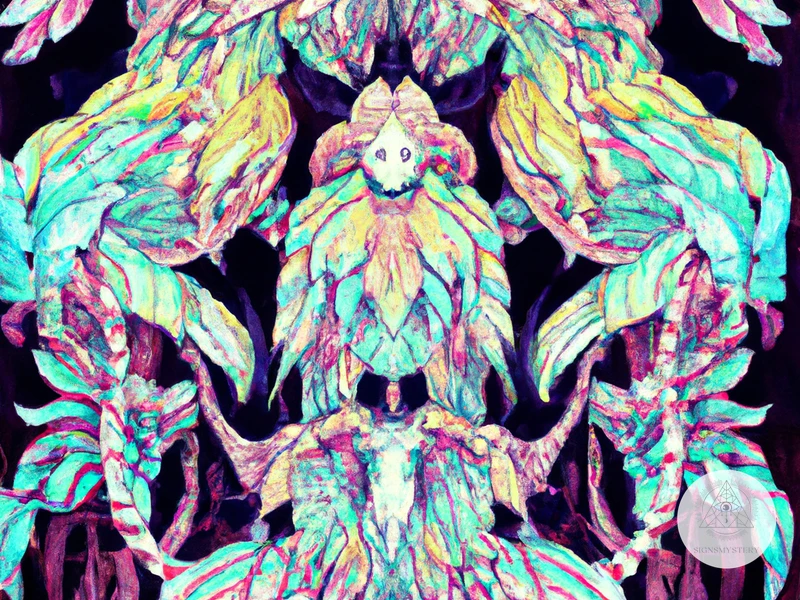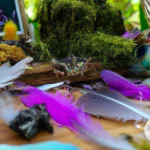For those looking to explore spiritual practices outside the bounds of traditional religions, neo-shamanism offers a novel opportunity. Rooted in ancient shamanic traditions, this modern-day spiritual practice emphasizes oneness with nature, spiritual alliances, and healing practices. In this article, we will delve into the core beliefs and practices of neo-shamanism, its history, and how it differs from traditional shamanism. We’ll also discuss the controversies surrounding this spiritual path, and whether it’s a worthwhile option for those seeking a deeper connection to the spiritual world.
What is Neo-shamanism?

Neo-shamanism refers to a modern spiritual practice that draws upon ancient shamanic traditions from various cultures worldwide. Practitioners of neo-shamanism view the world as an interconnected web of life and seek to reconnect with nature, spirits, and their true selves. The practice involves a wide range of beliefs and practices, including spiritual alliances with different energies, the power of nature, and oneness. Core practices include shamanic journeying, working with power animals and spirit guides, sacred ceremonies and rituals, and healing practices and energy work. However, neo-shamanism has also faced controversies regarding its ethics, dangers and use of psychedelics. To understand further the history and diversity of this spiritual path, it may be helpful to explore its origins, controversial role of psychedelics, neo-shamanic healing ethics, and practitioners’ attitudes towards nature and modern life.
The History of Neo-shamanism
Neo-shamanism is a modern interpretation of shamanism, an ancient practice that has been around for thousands of years across many cultures. The term “neo-shamanism” was first coined in the 1980s by anthropologist Michael Harner, who wanted to bring shamanic practices to the Western world.
At its core, neo-shamanism combines traditional shamanic beliefs and practices with modern spirituality, psychology, and new age philosophy. There are many different branches of neo-shamanism, but they all share a common goal of connecting individuals with their spiritual selves and the natural world.
While shamanism has been around for centuries, neo-shamanism has only been around for a few decades. However, it has quickly gained popularity in the Western world and beyond. Here are some key events in the history of neo-shamanism:
- The founding of the Foundation for Shamanic Studies by Michael Harner in 1979, which helped to spread shamanic practices in the United States and around the world.
- The publication of Harner’s influential book, “The Way of the Shaman,” in 1980, which introduced many Westerners to shamanic journeying and other shamanic practices.
- The emergence of other prominent figures in the neo-shamanic movement, such as Sandra Ingerman, who has written extensively on shamanism and helped to develop techniques for modern shamanic healing.
- The integration of shamanic practices into wider forms of alternative spirituality and New Age movements, which has helped to increase the popularity of neo-shamanism.
While it is a relatively new phenomenon, neo-shamanism has a rich history and a strong connection to traditional shamanic practices. By incorporating modern spirituality and psychology, neo-shamanism is a unique and powerful practice that can help people connect with their inner selves and the world around them. If you want to learn more about neo-shamanism and how you can get started with shamanic journeying and other practices, check out our Neo-Shamanic Journeying Guide for Beginners or our guide to choosing the right neo-shamanic practitioner.
Key Differences between Traditional and Neo-shamanism
Traditional shamanism has been practiced by indigenous peoples for centuries and is rooted in their ancestral cultures and traditions. It is a way of life that often involves communicating with spirits, including those of ancestors and nature. Traditional shamanic practices vary widely based on the culture and the region, and the use of psychoactive substances is common in some traditions. On the other hand, neo-shamanism is a modern concept that aims to integrate traditional shamanic practices into contemporary life. Neo-shamanism is not based on any specific culture or tradition and is therefore open to interpretation and adaptation.
One of the main differences between traditional and neo-shamanism is their origin and cultural context. Traditional shamanism is deeply rooted in the indigenous cultures and spiritual practices of various regions, while neo-shamanism is a modern concept that was developed in the West by people who were inspired by traditional shamanic practices.
Another important difference lies in the role of psychoactive substances. Traditional shamans often use these substances to enter a trance state and communicate with spirits. However, neo-shamans do not always use these substances and instead rely on other techniques such as drumming and meditation.
Additionally, traditional shamanism is often based on the idea of community, with the shaman being a central figure who serves the needs of the community through various spiritual practices. In neo-shamanism, the emphasis is more on individual spiritual exploration and personal development.
Finally, traditional shamanism often involves a specific set of cultural traditions and practices that are passed down through generations, while neo-shamanism involves creating new practices and adapting traditional ones to fit modern life.
It is worth noting that these are general differences and that traditional and neo-shamanic practices can overlap in some cases. Nonetheless, understanding these differences is crucial for anyone interested in exploring the history and origins of neo-shamanism and how it differs from traditional shamanism.
The Core Beliefs of Neo-shamanism
Neo-shamanism is based on the belief in spiritual alliances and connections with animals, spirits, and Nature that can aid in individual transformation and healing. The core beliefs of Neo-shamanism center around the power of reconnection with the natural world and the understanding of Oneness between all things. This spiritual path teaches that individuals can tap into spiritual realms through the practice of shamanic journeying and gain wisdom and guidance from power animals and spirit guides. Neo-shamanism emphasizes the importance of respect and gratitude towards nature, as it is considered a powerful force with transformative abilities. To learn more about the controversies surrounding Neo-shamanism, check out the article on Neo-Shamanic Healing Ethics and Dangers or read about how Neo-shamanism has adapted in the face of globalization by clicking here.
Spiritual Alliances and Connections
Neo-shamanism revolves around the belief that we are all interconnected on spiritual and energetic levels. In Neo-shamanism, there is a strong emphasis on building spiritual alliances and connections with the spirits of nature, ancestors, and other spiritual beings.
Shamans believe that by forming alliances with these spirits, they can gain access to spiritual knowledge and receive guidance for themselves and others. They also believe that these spirits can help them in their shamanic practices, such as healing and divination.
One key aspect of building spiritual alliances is through the practice of journeying, where a shaman enters a trance-like state and travels to other realms to meet with spirits. During these journeys, the shaman may meet with their power animals or spirit guides, who act as mentors and teachers.
Another way to build spiritual alliances is through sacred ceremonies and rituals, which are used to honor the spirits and seek their blessings. These ceremonies often involve offerings such as incense, herbs, and prayers, and may take place in natural settings like forests or rivers.
Neo-shamanism also highlights the importance of respecting and protecting the environment as a way to strengthen our spiritual connections and alliances. By honoring the natural world and its spirits, we not only gain their favor but also help to preserve the delicate balance of our planet.
Building spiritual alliances and connections is a crucial aspect of Neo-shamanism, and it involves practices such as journeying, sacred ceremonies, and environmentalism. By fostering these connections, shamans believe that they can gain spiritual knowledge and guidance and promote healing and balance in the world. For more information about neo-shamanic practices, see our article on neo-shamanic drumming styles.
The Power of Nature
In neo-shamanism, nature holds immense power as it is seen as a living, breathing entity that is interconnected with all beings. Practitioners believe that by connecting with nature, one can tap into the ancient wisdom and energy it holds, ultimately leading to spiritual growth, healing, and enlightenment.
Communing with Nature: Neo-shamans spend a significant amount of time in nature, where they connect with the earth, trees, water, and the sky. They believe that each element of nature has its own spirit, and by interacting with them, one can develop a deep bond with the natural world.
Nature-based Rituals: Many neo-shamanic rituals are centered around nature and its cycles. For example, the changing of the seasons or the phases of the moon are used to mark significant events in a practitioner’s spiritual journey. Some neo-shamans also incorporate natural objects, such as crystals or feathers, into their rituals to enhance their connection to the natural world.
Healing Properties of Nature: Nature is also seen as a powerful force for healing. Neo-shamans may lead participants on a nature walk, where they encourage them to connect with the plants and animals around them. This practice is believed to promote healing and balance within the body, mind, and spirit. Additionally, spending time in nature is said to help alleviate stress and increase feelings of well-being.
Respect and Responsibility for Nature: The power of nature also comes with a responsibility to protect it. Many neo-shamans are advocates for environmentalism and believe that it is their duty to care for the earth and minimize their impact on the natural world. This sense of responsibility is built into many neo-shamanic practices, and practitioners often strive to live in harmony with the environment.
Nature holds immense power in neo-shamanism, and practitioners believe that by connecting with the natural world, they can tap into ancient wisdom and energy to promote spiritual growth and healing. However, this power comes with a responsibility to respect and protect the environment. If you want to learn more about the intersection of neo-shamanism and environmentalism, check out our article on “Neo-Shamanism and Environmentalism“. Alternatively, if you’re interested in integrating neo-shamanic principles into your modern life, check out our article on “Integrating Neo-Shamanic Principles into Modern Life“.
Oneness and Interconnectedness
Oneness and interconnectedness are fundamental concepts in Neo-shamanism. This belief system sees all things as interconnected and part of a greater whole. Practitioners of Neo-shamanism believe that every person, animal, plant, and even inanimate objects possess a spirit and consciousness. They see themselves as part of a vast network of beings, each one contributing to the collective consciousness of the universe.
In Neo-shamanism, the idea of separation is seen as an illusion. Everything is interconnected and dependent on each other. This interconnectedness is not only a spiritual concept, but it also has a scientific basis. Quantum physicists have proven that everything in the universe is connected at its most fundamental level.
The belief in oneness and interconnectedness is crucial to the Neo-shamanic practice of healing. Practitioners believe that physical, emotional, and mental health is achieved by maintaining harmony with the interconnected network of beings. This harmony is achieved by living in alignment with natural cycles and energies and by respecting the earth and its resources.
The concept of oneness and interconnectedness also extends to the practice of divination in Neo-shamanism. Divination is a tool used by Neo-shamanic practitioners to communicate with the spirit world. They believe that everything in the universe is imbued with spiritual energy, and by tapping into this energy, they can receive guidance and insight.
The belief in oneness and interconnectedness is a central tenet of Neo-shamanism. It sets the foundation for the practice of spiritual connection, healing, and divination. The idea that all things in the universe are interconnected and part of a greater whole is not just a belief but a way of life for Neo-shamanic practitioners.
The Basic Practices of Neo-shamanism

Neo-shamanism is a spiritual practice that involves connecting with the spiritual world through various techniques. Some of the basic practices of neo-shamanism include shamanic journeying, which involves entering an altered state of consciousness to communicate with spirits or access higher levels of knowledge. Working with power animals and spirit guides is another key practice, as these entities offer guidance, protection, and support. Sacred ceremonies and rituals, such as drum circles or smudging with sage, help to create a space of heightened spirituality and connection. Additionally, neo-shamanism emphasizes the practice of healing and energy work, which can involve practices like reiki or crystal healing. Each of these practices is a powerful tool for connecting with the spiritual world and tapping into its wisdom and power.
Shamanic Journeying
Shamanic journeying is one of the core practices in Neo-shamanism, used for obtaining knowledge and guidance from the spiritual realm. This practice involves inducing a trance-like state of consciousness through the use of repetitive drumming, chanting, or other methods. During the journey, the shaman connects with his or her spirit guides, power animals, and other spiritual allies, seeking answers to questions, healing, and guidance.
The journey typically takes place in a sacred space, often in nature, and the shaman sets an intention for what he or she wishes to gain from the experience. The journey can take many forms, from exploring lower worlds to connect with power animals or ancestral spirits, to visiting upper worlds to connect with celestial beings. The shaman may also explore the middle world, which is the physical world we live in, but from a different perspective.
Each journey is unique and can be deeply personal, helping the shaman to understand their own spiritual journey and path. They may receive insights and revelations about their purpose, challenges they are facing, and actions they need to take. The shamanic journey can also be used for healing purposes, where the shaman can seek guidance on how to heal themselves or others.
While shamanic journeying has been practiced for thousands of years in many cultures, Neo-shamanism has adapted this practice for modern times, incorporating aspects of psychology and Western spirituality into the practice.
Some critics of Neo-shamanism argue that it is cultural appropriation and that non-Indigenous people should not practice shamanic journeying. Proponents of Neo-shamanism argue that it is a universal practice that can benefit anyone, regardless of their ancestry.
Shamanic journeying is a powerful tool for personal growth and spirituality in the context of Neo-shamanism. It allows the practitioner to connect with the spiritual realm and receive guidance and healing in a profound way.
Working with Power Animals and Spirit Guides
Another common practice in neo-shamanism is working with power animals and spirit guides. These entities can be thought of as helpers or allies that assist the shaman in their journey. Power animals are often seen as embodiments of certain qualities or characteristics – for example, a bear might represent strength and protection, while a wolf might represent loyalty and social unity.
Spirit guides, on the other hand, are seen as more evolved beings who can offer more nuanced guidance and support to the shaman. These guides may appear in various forms, such as angels, ancestors, or even aliens. Some neo-shamans believe that their guides are actually aspects of their own higher self or subconscious mind.
To work with a power animal or spirit guide, a neo-shaman may go into a meditative state or undertake a shamanic journey. They may then call upon their guide, which may appear in a literal or symbolic form. The guide may provide guidance, wisdom, or healing to the shaman.
However, it is important to note that the concept of power animals and spirit guides is not universally
Subscribe to Our Newsletter
Sign up to receive the latest news and updates.
Regardless, many neo-shamans still find great value in working with power animals and spirit guides, and see it as a way to connect with their own intuition and inner wisdom.
Sacred Ceremonies and Rituals
Sacred ceremonies and rituals are an integral part of neo-shamanism. These practices are designed to build a connection with spirits and the divine. Here are some of the most common sacred ceremonies and rituals in neo-shamanism:
| Vision quests | Vision quests are rituals that involve spending time alone in nature to gain insight and receive guidance from the spiritual realm. Participants are encouraged to fast, meditate, and sometimes take hallucinogenic substances to enhance their experience. |
|---|---|
| Fire ceremonies | Fire ceremonies are powerful rituals that use the element of fire to connect with the spiritual world. Participants will gather around a fire, smudging themselves with sage and other herbs, drumming, chanting, and praying. The fire is believed to transmute negative energy and help bring new intentions to fruition. |
| Plant medicine ceremonies | Plant medicine ceremonies, such as ayahuasca, peyote, and mushrooms, are becoming more widely known and used in neo-shamanic practices. These substances are believed to help expand consciousness and offer spiritual insights. However, they should only be taken in a controlled environment with a trained shaman or facilitator. |
| Sweat lodges | A sweat lodge is a dimly lit dome-shaped hut made from natural materials such as willow or cedar branches, with hot rocks placed in the center. Participants undergo purification and connect with the spiritual world through prayer, chanting, and deep breathing. |
| Celebration ceremonies | Celebration ceremonies are designed to honor significant life events, such as birth, initiation, weddings, and death. These ceremonies may include dancing, singing, feasting, and sharing stories. The purpose is to connect with the community, the spiritual world, and the cycles of life. |
It’s important to remember that these ceremonies and rituals should only be performed under the guidance of a trained shaman or facilitator. They can be powerful tools for spiritual growth and healing, but they should never be taken lightly.
Healing Practices and Energy Work
Healing Practices and Energy Work are central practices within Neo-shamanism. The belief that spiritual and physical health are interconnected is fundamental to this practice. Practitioners of Neo-shamanism believe that imbalances and negative beliefs can create blockages in the physical body. Healing practices aim to restore harmony and balance by addressing these blockages, which can manifest as physical and emotional discomfort.
Energy work is an essential component of Neo-shamanic healing practices. This involves working with the subtle energies that are believed to flow through the body. Practitioners of Energy work believe that everything is made up of energy, and by working with these energies, they can help to release blockages and promote healing. Techniques for energy work may include hands-on healing, visualization, or the use of crystals or other tools.
Shamanic healing ceremonies are often centered around the use of sound and rhythm, either through music, chanting, or drumming. These elements help to shift the practitioner into an altered state of consciousness, allowing them to access spiritual realms where healing can be performed. Within these ceremonies, the practitioner may work with different spirit allies, such as power animals or helping spirits, to facilitate the healing process.
Plant medicines are also used within Neo-shamanic healing practices, particularly in South American traditions like Ayahuasca or San Pedro. These plants are believed to have healing and transformative properties that can help to facilitate spiritual growth and healing. Practitioners say that plant medicines can help to clear energy blockages, release negative emotions, and awaken spiritual awareness.
Healing practices and energy work are integral to the Neo-shamanic path. By addressing imbalances on a spiritual level, practitioners aim to promote balance and well-being in the physical body and in all aspects of life. It’s important for those undertaking these practices to work with experienced and knowledgeable practitioners, as these practices can have powerful effects and require proper guidance and support.
Neo-shamanism: A Modern Twist on an Ancient Path
Neo-shamanism is a modern take on the ancient path of shamanism. It is a belief system that has come about as a result of people searching for spirituality and nature-based practices. This form of shamanism is not tied to any particular culture or tradition, but rather, it draws inspiration from many different sources.
One of the defining characteristics of neo-shamanism is its adaptability. Practitioners are not tied to specific dogmas or rituals, but rather, they are free to explore their own spiritual paths. This has led to the development of many different shamanic practices, each with its own unique style and flavor.
Neo-shamanism has evolved to incorporate modern technologies and techniques, making it accessible to a much wider audience. For example, many practitioners use drumming, rattling, and other forms of sound therapy to induce a trance-like state. Others use dance, meditation, and visualization techniques to connect with the spiritual world.
In many ways, neo-shamanism has become a global movement, with practitioners from all walks of life coming together to explore alternative forms of spirituality. This has also led to the development of online communities, where people can connect, learn, and share their experiences with one another.
Neo-shamanism represents a modern twist on an ancient path. It draws inspiration from the past, but is not bound by it. It is a diverse and adaptable belief system that is constantly evolving and growing. For those who are seeking a spiritual path that is connected to nature and the world around us, neo-shamanism is a compelling option.
The Controversies around Neo-shamanism
The controversies surrounding Neo-shamanism mainly arise from the appropriation of Indigenous cultural practices and beliefs. Some argue that Neo-shamanism is a form of cultural imperialism that perpetuates stereotypes and misrepresents Indigenous cultures. Others argue that Neo-shamanism is a legitimate spiritual practice that draws inspiration from various cultures.
One of the main criticisms of Neo-shamanism is the commodification of Indigenous cultural practices. For example, some Neo-shamans claim to offer traditional ceremonies or healing practices for a fee, which is seen as disrespectful and exploitative. This type of commercialization ignores the historical and cultural significance of these practices and reduces them to a product for profit.
Additionally, some argue that Neo-shamanism perpetuates harmful stereotypes and inaccuracies about Indigenous cultures. In some cases, Neo-shamans may use sacred objects or rituals without proper understanding or respect for their origins. This can lead to cultural misappropriation and a lack of understanding of the significance behind these practices.
Despite these controversies, some argue that Neo-shamanism can be a way for individuals to connect with their spirituality and the natural world. However, it is important for practitioners to approach the practice with respect, understanding, and humility. This includes avoiding cultural appropriation, acknowledging the historical and cultural significance of Indigenous practices, and seeking guidance from trained and respected practitioners when possible.
The controversies surrounding Neo-shamanism highlight the importance of respecting and honoring Indigenous cultures and practices. Practitioners of Neo-shamanism should approach the practice with humility and respect, and seek to learn from and honor the traditions that inspire their spiritual path.
Pros
- Can provide a pathway to spiritual connection and growth
- Learn from multiple cultures
- Can draw on ancient wisdom to address modern issues
Cons
- Can perpetuate harmful stereotypes about Indigenous cultures
- May engage in cultural appropriation and commodification of traditional practices
- Can lack understanding or respect of the history and cultural significance behind certain practices
Conclusion
In conclusion, Neo-shamanism is a fascinating spiritual practice that has captured the interest of many modern individuals seeking a deeper connection with the natural world and a greater understanding of their own inner selves. While it has faced controversy and criticism, it remains a valuable and relevant path for those who resonate with its core beliefs and practices.
Through exploring the history, key differences, core beliefs, and basic practices of Neo-shamanism, we can see that it is a modern twist on an ancient path that emphasizes spiritual alliances, the power of nature, and oneness. Shamanic journeying, working with power animals and spirit guides, sacred ceremonies and rituals, and healing practices and energy work are all integral to the Neo-shamanic experience.
It is important to note that while Neo-shamanism may share similarities with traditional shamanism, there are distinct differences, most notably in its approach to cultural appropriation and the use of psychoactive substances.
Overall, for those who are drawn to Neo-shamanism, it offers a rich and rewarding spiritual journey that can empower individuals to deepen their connection with themselves, the natural world, and the greater spiritual realm. It is up to each person to explore and determine whether this path is right for them, but for those who embrace it, the rewards can be profound and life-changing.
Table of Contents:
– Introduction
– What is Neo-shamanism?
– The History of Neo-shamanism
– Key Differences between Traditional and Neo-shamanism
– The Core Beliefs of Neo-shamanism
– Spiritual Alliances and Connections
– The Power of Nature
– Oneness and Interconnectedness
– The Basic Practices of Neo-shamanism
– Shamanic Journeying
– Working with Power Animals and Spirit Guides
– Sacred Ceremonies and Rituals
– Healing Practices and Energy Work
– Neo-shamanism: A Modern Twist on an Ancient Path
– The Controversies around Neo-shamanism
– Conclusion
Frequently Asked Questions
What makes Neo-shamanism different from traditional shamanism?
Neo-shamanism is a modern interpretation of shamanism that incorporates elements of various spiritual and religious practices, including Native American, Celtic, and Buddhist traditions, to name a few. It also emphasizes individual spirituality and personal transformation, which sets it apart from more communal and traditional shamanic practices.
What are the core beliefs of Neo-shamanism?
The core beliefs of Neo-shamanism emphasize oneness and interconnectedness, spiritual alliances and connections, and the power of nature. Practitioners believe that everything in the universe is connected and that spiritual journeys, connections with spirit guides, and the power of nature can help individuals achieve healing and personal transformation.
What is shamanic journeying?
Shamanic journeying is a practice used in Neo-shamanism that involves entering a trance-like state to travel to non-ordinary reality and connect with spiritual guides and other entities. This practice involves drumming, chanting, or other repetitive sounds to facilitate the journey.
What are power animals and spirit guides in Neo-shamanism?
Power animals are animal spirits that are believed to aid and protect individuals as they journey in the spiritual world. Spirit guides, on the other hand, are spirits that have a personal connection with the practitioner and can offer guidance and support in daily life. Both are central figures in Neo-shamanic practice.
What kinds of ceremonies and rituals are performed in Neo-shamanism?
Neo-shamanic ceremonies and rituals include sweat lodges, pipe ceremonies, vision quests, and other spiritual practices that involve deep connections with nature, animal spirits, and other spiritual entities. These rituals offer opportunities for healing, transformation, and spiritual connection.
What is the controversy surrounding Neo-shamanism?
Some scholars and cultural experts argue that Neo-shamanism is a form of cultural appropriation, as practitioners often borrow from and adapt traditional shamanic practices from other cultures. Others criticize the individualistic and new age aspects of the practice and question the legitimacy of spiritual experiences achieved through Neo-shamanic practices.
Can anyone practice Neo-shamanism?
Yes, anyone can practice Neo-shamanism, as it emphasizes personal spirituality and individual transformation. However, it is important to approach the practice with respect and understanding of its origins and cultural significance.
What is the role of a Neo-shamanic practitioner?
A Neo-shamanic practitioner serves as a guide and facilitator for individuals seeking to connect with spiritual entities, journey to non-ordinary reality, and achieve personal transformation. They have an understanding of traditional shamanic practices as well as other spiritual and religious practices that may inform their work.
Is Neo-shamanism recognized as a legitimate spiritual practice?
Neo-shamanism is not recognized as an official religion or spiritual practice in most countries. However, it has gained popularity in the new age and spiritual communities and continues to be studied and practiced by individuals seeking personal transformation and spiritual connection.
What is the ultimate goal of Neo-shamanism?
The ultimate goal of Neo-shamanism is personal transformation and spiritual connection. Practitioners believe that by connecting with spirit guides, nature, and other spiritual entities through shamanic practices, individuals can gain insight, healing, and connection to the universal energy that surrounds and connects us all.










